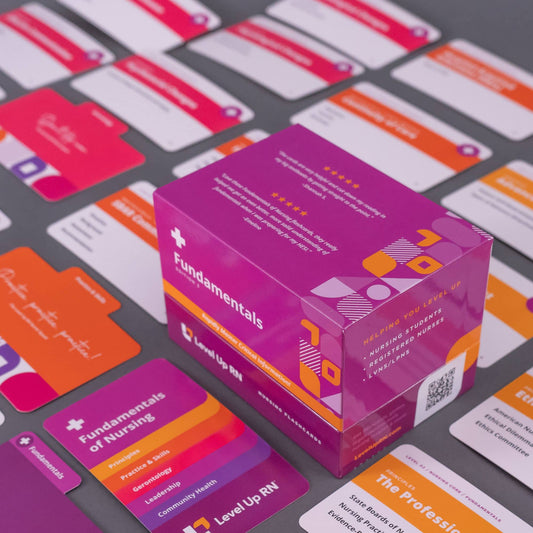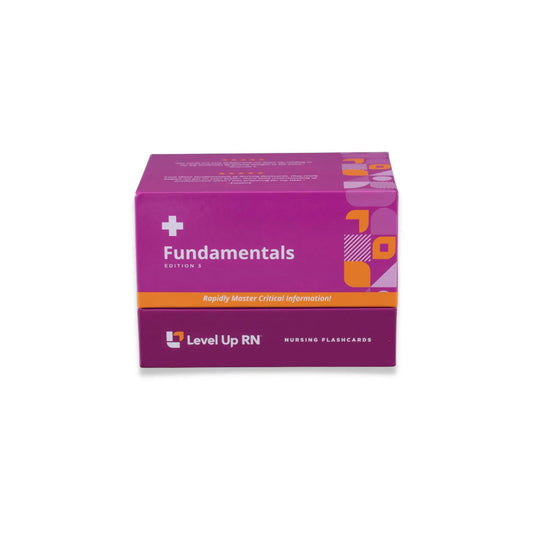- 00:00 What to expect - Community Health
- 00:33 Environmental Hazards
- 00:38 Air Pollution
- 1:12 Occupational Hazards
- 2:09 Water contamination
- 2:51 Food Desserts
- 3:31 Lead Poisoning
- 4:31 Nursing care
- 6:11 carbon monoxide poisoning
- 6:28 Risk Factors
- 6:50 Patient teaching
- 8:48 Signs & Symptoms
- 9:38 Quiz Time!
Fundamentals - Community Health, part 3: Environmental Hazards
Updated: Ellis Parker
Full Transcript: Fundamentals - Community Health, part 3: Environmental Hazards
Full Transcript: Fundamentals - Community Health, part 3: Environmental Hazards
Hi. I'm Ellis with Level Up RN. In this video, I'm continuing my conversation on community health, and I'll be covering environmental hazards to include lead poisoning and carbon monoxide poisoning. These cards are found in the community health section of our fundamentals flashcard deck. So if you have the deck, you can grab the cards and follow along because there's a lot of red text on these ones. If you don't have the deck, you can check us out at leveluprn.com. After I finish the content, I'll be asking you a couple of questions to check your knowledge.
We've broken down environmental hazards into four categories on this card. I'm going to start with air pollution or air quality. So when we're outdoors, this is going to be things like motor vehicle and industry emissions, including carbon monoxide, ground level ozone, and particulate matter. Indoors, we're more worried about tobacco smoke, asbestos, and mold. Asbestos being a material that has in the past been used for insulation in buildings and is very dangerous when inhaled. It causes lung damage.
The next category is occupational hazards, and these, of course, are going to vary widely depending on what somebody does for work. But different things that fall under occupational hazards are going to be, again, air pollutants or air contaminants, like being overly exposed to dust or mold or fumes and gases. Other things are going to include chemical and biologic hazards, like blood exposure for healthcare workers, for example, machine operation risks, heat and/or radiation exposure, and then ergonomic risks. And this is one that we see a lot because ergonomic risks just means risks to your bodily function. So back injuries is what's really common, and those are going to happen in people that have repetitive motion task jobs or jobs that require heavy lifting.
Our next category is water contamination. And this can be due to wastewater treatment discharge. It can be caused by chemical contamination, like farm runoff, if there is any usage of fertilizers or pesticides. And water contamination can also occur due to the type of pipes that are running the water and can especially cause lead exposure. I think this was actually fairly well known in our recent history due to the Flint, Michigan incident in which they had high levels of lead in their water that people were drinking and washing their dishes and bathing in.
And the final category on this card is food deserts. A food desert is a geographic area that has limited or completely lacks access to a sufficient amount of food, especially grocery stores that provide healthy food, and more importantly, fresh food options. So think about communities, especially in rural areas, but it can happen in urban areas as well, where people primarily get their food from gas stations or convenience stores, right? There's going to be a very limited amount of healthy alternatives and fresh food options.
Let's dive a little deeper into lead poisoning. Lead poisoning occurs when there has been an excess exposure to lead, and this can cause damage to the nervous system, including cognitive impairments. The primary risk factor for lead poisoning has to do with housing. Housing that was developed pre-1978 is much more likely to have lead-based paint because there were no laws or regulations preventing that from being used likely because they didn't know that that was going to cause problems. And so if someone is living in a home or living in a building that was built pre-1978, then we need to talk to them about lead-based paint exposure. Now, this exposure increases somebody's risk if home renovations are occurring because peeling or flaking paint is going to coat interior surfaces of the house as well as potentially get into the soil outside of the home and contaminate that as well. Nursing care for lead poisoning is screening patients to see if they're at risk, so asking about their housing situation and the year in which their housing was built so that we can determine their exposure potential to lead-based paint. Nursing care is also going to include evaluating [cerin?] levels of lead for those individuals that are determined to be at risk and providing chelation therapy for individuals whose lead [cerin?] level is above 45.
Another critical part of the nurses' responsibility for lead poisoning is to prevent it with education. So patient teaching is a critical part of this. Educating patients on checking for peeling or flaking or chipping paint and not picking at it or making it worse. And for cleaning purposes, wet mopping their floors would be more ideal because sweeping or vacuuming is going to make all of those particulates go up into the air and then potentially be inhaled. So wet mopping instead would be able to collect all the flaking and paint chips and particulates and remove them without that happening. And then if there are children in the home, it's even more critical to discuss things like washing toys and pacifiers, washing children's hands and mouths, preventing them from digging in or playing in the soil that's surrounding the home to prevent that excess lead exposure. And it might also include increasing a child's intake of calcium and iron as that will decrease lead absorption.
The final topic we'll be reviewing in this video is carbon monoxide poisoning. This is a toxicity from carbon monoxide, which is a tasteless, colorless, and odorless gas. And the poisoning can lead to severe illness, and it could also lead to death. There are a lot of risk factors for carbon monoxide poisoning. Some are more controllable than others. These include poor ventilation, usage of indoor heating equipment that's malfunctioning. Car exhaust has carbon monoxide in it. And house fires will also expose people to carbon monoxide. The nurses primary role in carbon monoxide poisoning is patient teaching. So our patient teaching needs to include ways to prevent exposure to carbon monoxide as well as how to recognize the signs and symptoms.
To prevent exposure, we want to recommend that patients implement a carbon monoxide detector. Those look a lot like smoke detectors, but they measure the amount of carbon monoxide in the environment and will alarm if it is an unsafe level. And this is really critical because, like I just said, carbon monoxide is tasteless, colorless, and odorless. And unfortunately, that means that people are not aware that they're being exposed to it sometimes, which is why it can lead to death. Other things that we want to educate people on on how they can avoid exposure is to make sure that whatever their heating unit is that it is maintained and functioning correctly and to make sure that there's adequate ventilation, especially when using something that produces carbon monoxide. And so this is really key. We want to make sure that we are recommending that people do not use any item that is run on gasoline or charcoal. And that's going to mean generators, grills, camp stoves, heating units, right? All of those different devices should never be used inside a home, inside a basement, inside a garage, right, anywhere where ventilation could in some way be limited. We should not be using a product that produces carbon monoxide.
Furthermore, we want to educate patients on the signs and symptoms of carbon monoxide poisoning so that hopefully they can identify those symptoms early and remove themselves from that situation, improve the ventilation that they have access to, go outside maybe, and reduce their exposure before it causes permanent damage or, again, before it leads to death. So those early signs and symptoms are going to include a headache, dizziness, nausea, and confusion or disorientation. And a key point on this card for you to remember is that carbon monoxide binds to hemoglobin in place of oxygen. So if I am worried that someone is experiencing carbon monoxide poisoning, it's important to note that they will have a normal pulse oximetry reading, which we might interpret as good oxygen status, but it doesn't mean that oxygen is binding to the hemoglobin. The carbon monoxide will bind to the hemoglobin as well.
And that's all the content that we have for this video, so just hang tight because I've got a couple of questions to check your knowledge. Define a food desert. A food desert is a geographic location that lacks sufficient access to grocery stores and healthy food options like fresh foods. What is the primary risk factor for lead poisoning? The primary risk factor for lead poisoning is housing that was built before 1978, especially during times of renovation. What are the symptoms of carbon monoxide poisoning? Carbon monoxide poisoning can lead to headaches, dizziness, nausea, and confusion. Thank you for studying with me. I hope you enjoyed. Next time, I'll be talking about vulnerable populations and violence in the community. If you have any questions or feedback, we'd love to hear it.


